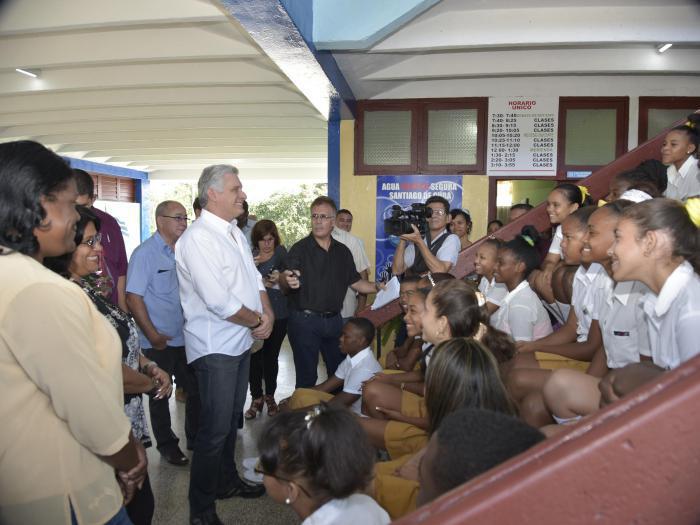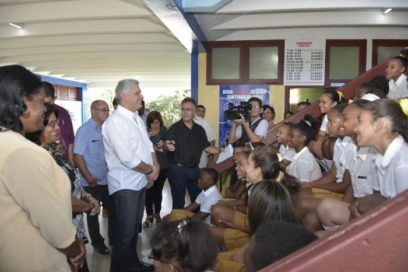
Located in the Chicharrones People’s Council in this provincial capital, is the Armando García Aspuru Middle School, the first site visited by Miguel Díaz-Canel Bermúdez, President of Cuba’s Councils of State and Ministers, on his June 20 tour here.
This first visit by the country’s new President has a special connotation, since Santiago de Cuba, thanked by Fidel for all that its people have done for the Revolution, is the birthplace of heroes and martyrs, with a vast, rich history that continues to be written.
This is where we start, because as the poetry of Waldo Leyva says, displayed on a wall along the city’s Enramadas Boulevard, “If you discover a street where a hero has never walked… there is no Santiago.”
Minutes before the President arrived – accompanied by Lázaro Expósito Canto, first secretary of the Party in the province; and Beatriz Jonhson Urrutia, Council of State vice president and President of the Provincial Assembly of People’s Power, as well as other authorities – the middle school’s principal, Rosa Sánchez Braña, said she was proud to host the distinguished guest. She has led the school for eight years, and with the passion of a good teacher, explained that the Armando García has a student body of 361 seventh, eight, and ninth graders, and a staff of 53, of whom 41 are educators. Filling the stairwell that leads to the second floor of the school, decked out in Cuban flags, students greeted Díaz-Canel. They did so with expressions of gratitude to Fidel, verses from Martí, excerpts from the concept of Revolution bequeathed by the Comandante en Jefe to all Cubans, and with song.
The President began the exchange right away, at the foot of the stairs, asking questions about a wide range of issues: How are school days spent? Do you like to dance? How are career interest groups conducted? What time to you get up in the morning? What’s for lunch? What do you do before bed? When do you study and how? Do you take advantage of you courses’ software collections? What do you do for fun on weekends?
The questions put students on the spot, and as they shared their opinions, the President asked for more information: Do you like Santiago? Are your teachers good? What do you – and not like – about the school? Are there places in the community for recreation? What would you like to study in the future?
Díaz-Canel told the group, almost all of whom want to be doctors, that he would leave with the impression that they felt good, and pleased that “there are students like you, so decent, well prepared, and committed to the Revolution.”
“Surely there’s some little thing here that could be improved,” he insisted, as he concluded, before saying that commitment to the Greater Homeland begins where you live, that if the students love their neighborhood, with its tremendous history of struggle, then they love the Revolution.
The welcome concluded with Sánchez granting the President honorary recognition in the name of the province’s educational system and a bouquet of flowers. Díaz-Canel then toured the facilities and held a meeting with the school’s leadership and other teachers.
Toward the end of the visit, the President approached the school yard where several students were playing basketball. After joining the game for a few minutes, he made a basket, drawing laughter and applause from those present.
Grateful for the encounter, Díaz-Canel departed for another location in the heroic city, but not before stopping to greet and chat with residents of the Chicharrones neighborhood, who gathered outside the school as they heard the President was there.
At the Dr. Antonio María Béguez César Children’s Hospital of the South there are two departments of special sensitivity: those of pediatric oncology and hematology. The Cuban President arrived and inquired if services in all medical specialties were available and how many patient-beds the hospital had.
The staff members who welcomed him explained that the hospital has a total of 1,178 workers, and of these 198 are doctors.
Díaz-Canel asked about an issue of interest to all: How much is hereditary, and how much is environmental, in causing diseases that concern scientists?
And then: How are working conditions in the hospital, especially for doctors? What do you believe is lacking here?
The President of Santiago’s Provincial Assembly of People’s Power Beatriz Jonhson Urrutia responded, mentioning an important goal: making investments to create more comfortable spaces where children and their mothers can stay together, during treatment here.
Díaz-Canel continued his tour, and as the group walked, he asked about how young patients can keep up with their school work during recovery. Before departing, he congratulated the staff, wishing them success, and encouraging them to continue their good work in the beautiful battle for life.
Wherever there are many intelligent people, you can be sure things will turn out well, Díaz-Canel said as he toured the Oriente Pharmaceutical Laboratory Enterprise, devoted to producing and distributing medications, natural products, nutritional supplements, and medical equipment.
Sandra Echevarría Lafargue, adjunct director of the state company, updated the President on the performance of the five production lines here, all with an important impact on the population’s quality of life, including tablets; parenteral solutions in large volume plastic bags; concentrated dialysis solutions; medical equipment; and powders such as oral rehydration salts.
Lafargue explained that the laboratory is undertaking new efforts, including the introduction of Moringa tablets; reformulating alprazolam and aspirin; developing a new packaging material to extend the shelf life of parenteral solutions; and advancing specialties like multi-electrolyte solutions. Work is also being done, she said, on acquiring technology for high blood pressure medications and other products like 500mg Dipirona tablets.
Díaz-Canel expressed special interest in the company’s natural products, a line that has distinguished the Laboratory, noting the importance of continuing to develop specialists in this arena.
“I see that you have been able to get around obstacles,” the President commented to workers, noting the company’s innovative accomplishments in the 2017 Science and Technique Forum, where the company’s staff presented 352 works addressing specific issues and offering solutions. The proposals led to the resolution of dozens of problems identified within the facility, and won them recognition on a municipal level.
Upon departing, the President greeted and talked with residents of the “30 de Noviembre” community who were waiting outside to welcome him.
Another site visited by Díaz-Canel, along with Lázaro Expósito, Beatriz Jonhson, Minister of Construction René Mesa Villafaña, and other provincial authorities, was the residential settlement of El Carmen, being constructed 18 kilometers from the center of the provincial capital. To be inaugurated here shortly are 73 houses for families who lost their homes during Hurricane Sandy in 2012 and others facing precarious housing situations.
The President was updated on details of the project, such as the types of dwellings being built: 60 of “Type 4” design using wood and masonry; and 13 of the “Sandino” masonry design. The Santiago municipal Construction Maintenance Enterprise, the Guamá Agro-forestry Enterprise, and the Gran Piedra Baconao Agro-forestry Enterprise, have carried out the project to provide homes for those who lost practically everything or who are living in very difficult conditions.
Describing the lumber used to erect houses, the director of Gran Piedra explained to the press that the wood has special resistance and strength.
How are future residents feeling? Do they have access to water and other services? The President took an interest in such issues during a meeting with a group of people from Santiago working at the settlement, who will become owners, although they don’t yet know which house will be theirs.
Díaz-Canel encouraged them to take good care of the gardens that will continue growing and the paint on houses in the future, so that El Carmen maintains its beauty for a long time.
The President’s afternoon agenda included a stop at the Marcel Bravo factory that produces 55 gallon metal barrels, in the province’s industrial zone. Every step of the process captured his attention, and he talked with both management personnel and workers. The plant supplies barrels to several eastern provinces from Guantánamo to Sancti Spíritus, where they are used to store foodstuffs, lubricants, fuel, and paint.
Located not far from the bay where tanks are manufactured, is another unit where metal parts are forged. Díaz-Canel walked over to observe the process of fabricating iron culverts and talk with workers involved in the task.
Next, the President took the Mar Verde Highway around Santiago to visit one of the province’s five refrigerated fish processing centers, where food for five eastern provinces is stored. Here he heard reports detailing the facility’s operations.
Another stop in the area was the Santiago fibrocement plant, and specifically the Petrocasas-Caribe facility, undergoing a significant investment process. Among other questions, Díaz-Canel asked about the technology that will be used, as well as the benefits projected for the population.
The visit to sites of economic interest ended in the afternoon with a tour of retail stores under construction on the provincial capital’s Central Highway, which will be opening soon. As for the facilities, something can already be said: They will be beautiful and represent another task completed in efforts to improve the wellbeing of those who have nurtured the Revolution since the beginning: the people of Santiago. (Taken from en.granma.cu)


